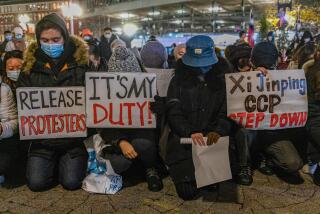Business Community Could Learn From Women’s Event in China
- Share via
One of the most remarkable aspects of the recent women’s conference in China was the marriage of capitalism and technology among the approximately 30,000 women from around the world who gathered far from the main event.
There actually were two conferences: the U.N. Fourth World Conference on Women in Beijing and the separate Non-Governmental Organizations Forum on Women held in Huairou, an hour bus ride away. The 30,000 NGO participants--six times the number of delegates in Beijing--represented a wide variety of volunteer, grass-roots and other types of non-government-sponsored organizations.
Those attending as NGO representatives were mostly women while the U.N. conference delegation was composed equally of men and women. The NGO delegates were housed in unfinished dwellings where the surrounding dirt quickly turned to mud when it rained, while the U.N. delegates had rooms in nice hotels. The NGO interactions were mostly unstructured, and there was no hierarchy of power and authority. U.N. delegates were more formal, paying attention to protocol and the political concerns of their governments.
When the sun came out, the U.N. delegates went into rooms to debate issues and wording, while the NGO participants went outside and set up colorful tables, workshop areas and vending booths. Here they exchanged products that included crafts, food, clothing and toys in addition to platform proposals and personal experiences. It was capitalism at its best, with thousands of women marketing and selling their ideas and wares in an environment where physical and language barriers toppled as they connected one to another.
*
In a sense, the NGO forum was like an off-Broadway production whose value is recognized but does not receive the attention of a Broadway show. While the debate taking place at the U.N. conference made news, the flourishing commerce taking place in Huairou received virtually no coverage.
Marsha Dubrow, president and CEO of Technolog Inc. of Montclair, N.J., participated at both the U.N. and NGO events. She observed that “the NGO forum resembled a ‘World’s Fair’ where women attended workshops on starting businesses, obtaining credit, marketing products and managing grass-roots organizations, along with singing, dancing and exchanging pictures of their children.”
At the same time, they vigorously debated ideological differences and difficult economic and social issues in an atmosphere of mutual respect.
The official document produced at the U.N. conference was called a Platform for Action, and suggested that women are united in their effort to improve their lives and their communities. It also implied that the process by which the U.N. document was developed--a collaborative effort on the part of U.N. delegates, NGO representatives and women around the world joining in from their homes and offices--was a model worth studying. The collaboration was enhanced largely because of a free e-mail list called BEIJING95-L.
The idea to provide BEIJING95-L to women who otherwise would have had to pay for information about the conference came from Jennifer Gagliardi, a computer technician from Palo Alto. She went to China at her own expense where she gathered information, put it on-line and encouraged others to contribute to the e-mail conversation while the conference was taking place. She was an important member of a 40-member all-female team that “manned” the successful Internet operation.
Printouts of BEIJING95-L messages as the deliberations were going on provided a colorful story of what took place in China. More importantly, it made available information that might not have been widely disseminated.
For example:
* Women from the Fiji Islands told of their educational system beamed throughout the islands, a model that could be used in other sparsely populated regions of the world.
* Finnish women told how they were able to interact with their U.N. and NGO representatives in a single conference call from their home phones.
* The AMARC-Europe Women’s Network, (the regional section of the World Assn. of Community Radio Broadcasters) in conjunction with Radio Lux (an independent radio station in Ukraine) told of a series of training seminars aimed at building a network for women in newly emerging community-based radio stations in Eastern and Central Europe.
Gagliardi and others listed e-mail networks dedicated to specific areas of interest to women, how to access them and how to become more technically proficient. In other words, BEIJING95-L provided thousands of women connections galore.
*
In her new book “World Class,” Rosabeth Kanter says that to succeed, “companies need abundant stocks of three global assets--concepts, competence and connections--which derive from investments in innovation, education and collaboration.” That’s what the “off-Broadway” NGO forum in Huairou and the “Broadway” production U.N. conference in Beijing were all about. The women hammered out complicated social and economic concepts in such areas as health, education, agriculture and human rights.
They exhibited competence by translating the concepts that became the essence of the conference’s final document into action plans to be implemented in their respective communities. And they established personal and technological connections that were innovative, educational and collaborative. Most impressive, using state-of-the-art technology, women in Beijing created an inclusive decision-making environment where there were no “glass ceilings,” and where they could in fact “think globally and act locally.”
Perhaps there’s a message here for business.
More to Read
Inside the business of entertainment
The Wide Shot brings you news, analysis and insights on everything from streaming wars to production — and what it all means for the future.
You may occasionally receive promotional content from the Los Angeles Times.










